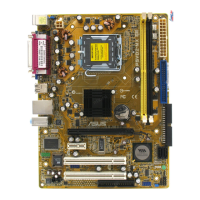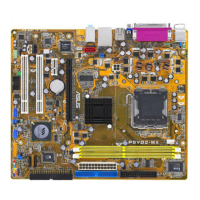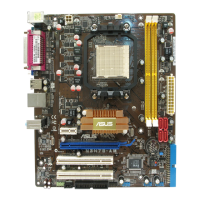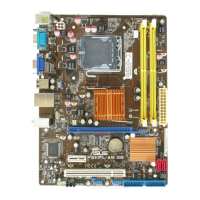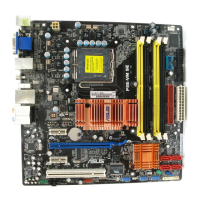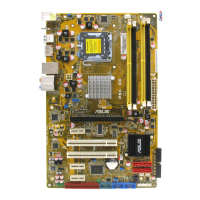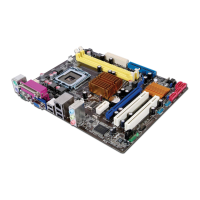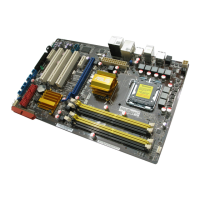Do you have a question about the Asus P5VD2-VM SE and is the answer not in the manual?
Details FCC compliance for digital devices and radio frequency emissions.
Outlines compliance with Canadian regulations for radio noise emissions.
Precautions to prevent electrical shock during system handling and component installation.
Guidelines for safe operation, handling components, and environmental considerations.
Describes the structure and content of the user guide, outlining its main parts.
Provides resources for additional product and software update information.
Explains text formatting conventions like bold, italics, and key notation used in the manual.
A greeting and introduction to the ASUS P5VD2-VM SE motherboard.
Lists all items included in the motherboard package for user verification.
Highlights key technologies and features of the motherboard.
Details specific product features like Intel Core™2 processor readiness and high-speed bus support.
Describes unique ASUS technologies such as CrashFree BIOS 2 and Q-Fan.
Outlines essential precautions before installing hardware components or changing settings.
Provides a general look at the motherboard and its layout.
Guides on orienting the motherboard correctly within the computer chassis.
Specifies the location and use of screw holes for securing the motherboard.
Illustrates the physical arrangement of components and connectors on the motherboard.
Information on installing and handling the CPU and its associated components.
Step-by-step instructions for correctly installing a CPU into the LGA775 socket.
Guides on mounting the CPU heatsink and fan assembly for optimal thermal performance.
Instructions for safely removing the CPU heatsink and fan assembly.
Details on installing and configuring DDR2 memory modules.
Introduces the DDR2 DIMM sockets and their specifications.
Explains compatible memory module types and capacity limitations.
Step-by-step guide for inserting DDR2 DIMMs into the motherboard sockets.
Instructions for safely removing DDR2 DIMMs from the motherboard sockets.
Information on installing and configuring various expansion cards.
Procedure for physically installing an expansion card into a slot.
Steps for setting up installed expansion cards via BIOS and drivers.
Table detailing IRQ assignments for motherboard devices and expansion slots.
Describes the types of cards supported by PCI slots.
Details the functionality and supported cards for the PCI Express x1 slot.
Explains the PCI Express x16 slot for graphics cards.
Explains the function and configuration of motherboard jumpers.
Instructions for clearing the CMOS Real Time Clock RAM to reset BIOS settings.
Configuration for enabling system wake-up via keyboard or USB devices.
Describes the motherboard's rear panel and internal connectors.
Details the function and location of all ports on the rear I/O panel.
Describes the function and location of internal motherboard headers and connectors.
Specifies the connector for the floppy disk drive signal cable.
Details the connector for IDE hard drives and configuration options.
Explains the SATA connectors for hard drives and RAID configurations.
Describes the connector for S/PDIF digital audio output modules.
Details the connectors for CPU and chassis cooling fans.
Explains the connector for internal audio input sources like CD-ROMs.
Describes the 24-pin ATX and 4-pin ATX12V power connectors.
Details the connector for chassis intrusion detection sensors.
Specifies the internal USB 2.0 connectors for front panel modules.
Describes the connector for front panel audio jacks (HD Audio/AC'97).
Details the connector for the system warning speaker.
Explains connectors for system LEDs, power button, and reset button.
Covers utilities and methods for updating the motherboard's BIOS.
Utility for updating BIOS within the Windows environment.
Instructions for creating bootable floppy disks for BIOS updates.
BIOS-integrated utility for easy BIOS updates without OS.
DOS-based utility for updating and backing up BIOS files.
Tool for recovering corrupted BIOS using support CD or floppy disk.
Introduction to the BIOS Setup utility and system configuration.
Overview of the BIOS Setup utility interface elements.
Describes the main navigation categories within the BIOS Setup.
Explains the keyboard keys used to navigate the BIOS menus.
Details the specific configuration options available within each BIOS menu.
Explains how to access and interpret sub-menus indicated by triangles.
Describes how to view and change settings within BIOS configuration fields.
Explains how pop-up windows display configuration options for specific items.
Describes the use of scroll bars to view all options on a menu screen.
Explains the context-sensitive help provided at the top right of BIOS screens.
Displays basic system information and core settings.
Allows setting the system's current time.
Allows setting the system's current date.
Configuration for the installed floppy disk drive type.
Displays and configures connected IDE and SATA storage devices.
Shows auto-detected BIOS, CPU, and memory specifications.
Contains settings for CPU, chipset, and other system devices.
Settings for managing USB ports and related features.
Options for configuring CPU-related advanced settings and features.
Advanced configuration for the Northbridge and Southbridge chipsets.
Settings specific to the NorthBridge VIA P4M900 chipset.
Adjusts DRAM frequency and timing parameters for memory performance.
Settings for enabling or disabling onboard hardware devices.
Configuration options for Plug and Play (PnP) devices and IRQ assignments.
Settings related to ACPI and Advanced Power Management (APM).
Configures the system's power states for suspend modes.
Enables or disables support for ACPI 2.0 specifications.
Controls ACPI support within the Advanced Programmable Interrupt Controller.
Advanced Power Management settings for system wake-up and power loss behavior.
Displays system temperatures, fan speeds, and voltages.
Options for configuring system boot order and settings.
Sets the sequence of devices for system startup.
Customizes boot behavior like Quick Boot and logo display.
Settings for system passwords and user access levels.
Procedure to set or change the supervisor password for BIOS access.
Defines the level of access users have to BIOS setup items.
Procedure to set or change a user password for BIOS access.
Option to remove a user password.
Configures when the system checks for user passwords.
Options for saving, discarding changes, or loading default BIOS settings.
Saves current BIOS settings and exits the setup utility.
Exits the setup utility without saving any changes.
Restores previously saved BIOS settings without exiting.
Loads the factory default BIOS settings.
Guidelines for installing supported operating systems on the motherboard.
Details the contents and usage of the motherboard's support CD.
Instructions on how to launch the support CD interface.
Lists and describes the available device drivers on the support CD.
Lists and describes the software utilities included on the support CD.
Provides options for creating utility disks, such as RAID driver disks.
Offers access to supplementary user manuals in PDF format.
Provides contact details for ASUS technical support and general inquiries.
Access to motherboard specifications, CD contents listing, and support forms.
Information on setting up Serial ATA hard disk drives in RAID configurations.
Explains RAID 0 (striping), RAID 1 (mirroring), and JBOD (spanning) concepts.
Steps for physically installing SATA hard drives for RAID.
Guides on configuring RAID settings within the BIOS and VIA utility.
Instructions for creating bootable RAID driver disks.
Procedure for creating a RAID driver disk using BIOS and CD.
Method for creating a RAID driver disk from within the Windows OS.
Details FCC compliance for digital devices and radio frequency emissions.
Outlines compliance with Canadian regulations for radio noise emissions.
Precautions to prevent electrical shock during system handling and component installation.
Guidelines for safe operation, handling components, and environmental considerations.
Describes the structure and content of the user guide, outlining its main parts.
Provides resources for additional product and software update information.
Explains text formatting conventions like bold, italics, and key notation used in the manual.
A greeting and introduction to the ASUS P5VD2-VM SE motherboard.
Lists all items included in the motherboard package for user verification.
Highlights key technologies and features of the motherboard.
Details specific product features like Intel Core™2 processor readiness and high-speed bus support.
Describes unique ASUS technologies such as CrashFree BIOS 2 and Q-Fan.
Outlines essential precautions before installing hardware components or changing settings.
Provides a general look at the motherboard and its layout.
Guides on orienting the motherboard correctly within the computer chassis.
Specifies the location and use of screw holes for securing the motherboard.
Illustrates the physical arrangement of components and connectors on the motherboard.
Information on installing and handling the CPU and its associated components.
Step-by-step instructions for correctly installing a CPU into the LGA775 socket.
Guides on mounting the CPU heatsink and fan assembly for optimal thermal performance.
Instructions for safely removing the CPU heatsink and fan assembly.
Details on installing and configuring DDR2 memory modules.
Introduces the DDR2 DIMM sockets and their specifications.
Explains compatible memory module types and capacity limitations.
Step-by-step guide for inserting DDR2 DIMMs into the motherboard sockets.
Instructions for safely removing DDR2 DIMMs from the motherboard sockets.
Information on installing and configuring various expansion cards.
Procedure for physically installing an expansion card into a slot.
Steps for setting up installed expansion cards via BIOS and drivers.
Table detailing IRQ assignments for motherboard devices and expansion slots.
Describes the types of cards supported by PCI slots.
Details the functionality and supported cards for the PCI Express x1 slot.
Explains the PCI Express x16 slot for graphics cards.
Explains the function and configuration of motherboard jumpers.
Instructions for clearing the CMOS Real Time Clock RAM to reset BIOS settings.
Configuration for enabling system wake-up via keyboard or USB devices.
Describes the motherboard's rear panel and internal connectors.
Details the function and location of all ports on the rear I/O panel.
Describes the function and location of internal motherboard headers and connectors.
Specifies the connector for the floppy disk drive signal cable.
Details the connector for IDE hard drives and configuration options.
Explains the SATA connectors for hard drives and RAID configurations.
Describes the connector for S/PDIF digital audio output modules.
Details the connectors for CPU and chassis cooling fans.
Explains the connector for internal audio input sources like CD-ROMs.
Describes the 24-pin ATX and 4-pin ATX12V power connectors.
Details the connector for chassis intrusion detection sensors.
Specifies the internal USB 2.0 connectors for front panel modules.
Describes the connector for front panel audio jacks (HD Audio/AC'97).
Details the connector for the system warning speaker.
Explains connectors for system LEDs, power button, and reset button.
Covers utilities and methods for updating the motherboard's BIOS.
Utility for updating BIOS within the Windows environment.
Instructions for creating bootable floppy disks for BIOS updates.
BIOS-integrated utility for easy BIOS updates without OS.
DOS-based utility for updating and backing up BIOS files.
Tool for recovering corrupted BIOS using support CD or floppy disk.
Introduction to the BIOS Setup utility and system configuration.
Overview of the BIOS Setup utility interface elements.
Describes the main navigation categories within the BIOS Setup.
Explains the keyboard keys used to navigate the BIOS menus.
Details the specific configuration options available within each BIOS menu.
Explains how to access and interpret sub-menus indicated by triangles.
Describes how to view and change settings within BIOS configuration fields.
Explains how pop-up windows display configuration options for specific items.
Describes the use of scroll bars to view all options on a menu screen.
Explains the context-sensitive help provided at the top right of BIOS screens.
Displays basic system information and core settings.
Allows setting the system's current time.
Allows setting the system's current date.
Configuration for the installed floppy disk drive type.
Displays and configures connected IDE and SATA storage devices.
Shows auto-detected BIOS, CPU, and memory specifications.
Contains settings for CPU, chipset, and other system devices.
Settings for managing USB ports and related features.
Options for configuring CPU-related advanced settings and features.
Advanced configuration for the Northbridge and Southbridge chipsets.
Settings specific to the NorthBridge VIA P4M900 chipset.
Adjusts DRAM frequency and timing parameters for memory performance.
Settings for enabling or disabling onboard hardware devices.
Configuration options for Plug and Play (PnP) devices and IRQ assignments.
Settings related to ACPI and Advanced Power Management (APM).
Configures the system's power states for suspend modes.
Enables or disables support for ACPI 2.0 specifications.
Controls ACPI support within the Advanced Programmable Interrupt Controller.
Advanced Power Management settings for system wake-up and power loss behavior.
Displays system temperatures, fan speeds, and voltages.
Options for configuring system boot order and settings.
Sets the sequence of devices for system startup.
Customizes boot behavior like Quick Boot and logo display.
Settings for system passwords and user access levels.
Procedure to set or change the supervisor password for BIOS access.
Defines the level of access users have to BIOS setup items.
Procedure to set or change a user password for BIOS access.
Option to remove a user password.
Configures when the system checks for user passwords.
Options for saving, discarding changes, or loading default BIOS settings.
Saves current BIOS settings and exits the setup utility.
Exits the setup utility without saving any changes.
Restores previously saved BIOS settings without exiting.
Loads the factory default BIOS settings.
Guidelines for installing supported operating systems on the motherboard.
Details the contents and usage of the motherboard's support CD.
Instructions on how to launch the support CD interface.
Lists and describes the available device drivers on the support CD.
Lists and describes the software utilities included on the support CD.
Provides options for creating utility disks, such as RAID driver disks.
Offers access to supplementary user manuals in PDF format.
Provides contact details for ASUS technical support and general inquiries.
Access to motherboard specifications, CD contents listing, and support forms.
Information on setting up Serial ATA hard disk drives in RAID configurations.
Explains RAID 0 (striping), RAID 1 (mirroring), and JBOD (spanning) concepts.
Steps for physically installing SATA hard drives for RAID.
Guides on configuring RAID settings within the BIOS and VIA utility.
Instructions for creating bootable RAID driver disks.
Procedure for creating a RAID driver disk using BIOS and CD.
Method for creating a RAID driver disk from within the Windows OS.
| Form Factor | Micro ATX |
|---|---|
| Socket Type | LGA 775 |
| Memory Slots | 2 |
| Maximum Memory | 4 GB |
| IDE | 1 x ATA133 |
| Audio Channels | 6-Channel |
| LAN Chipset | VIA VT6103L |
| LAN Speed | 10/100 Mbps |
| PS/2 | 1 x PS/2 Keyboard, 1 x PS/2 Mouse |
| Video Output | VGA |
| Supported CPU | Intel Core 2 Duo / Pentium D / Pentium 4 / Celeron |
| Front Side Bus | 533/800/1066 MHz |
| Memory Standard | DDR2 667 / 533 |
| Expansion Slots | 1 x PCIe x16, 1 x PCIe x1, 2 x PCI |
| Storage Interface | SATA and IDE |
| SATA | 2 x SATA 3.0 Gb/s |
| USB Ports | 8 x USB 2.0 |

